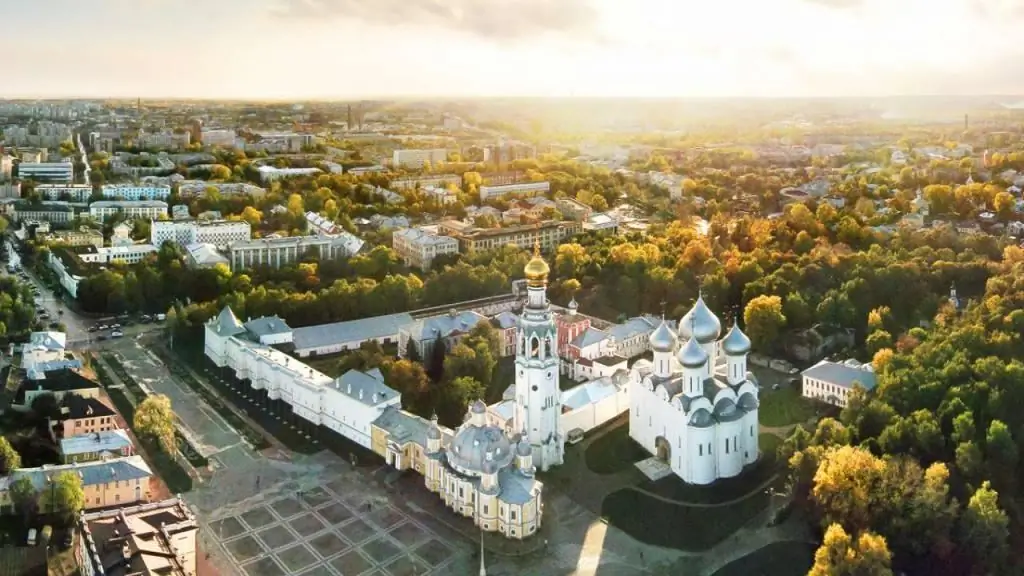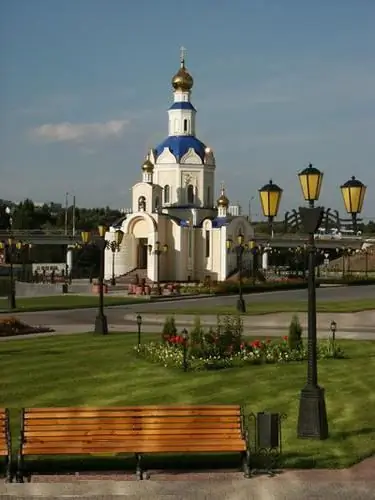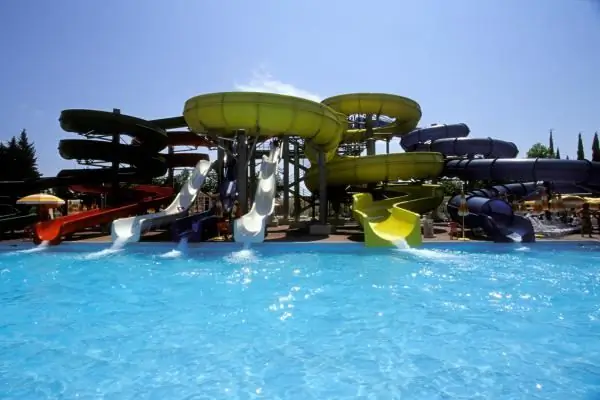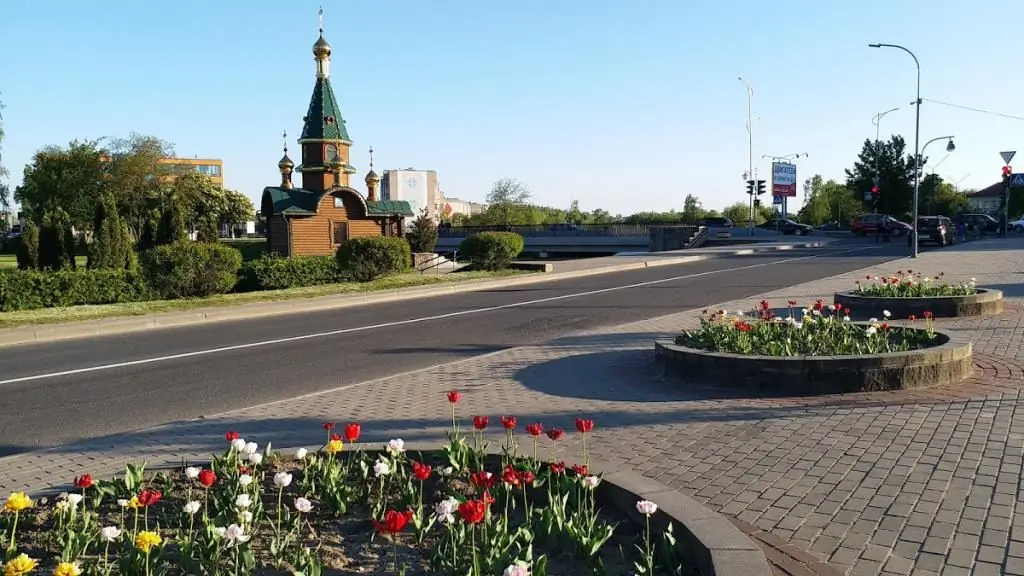- Author Harold Hamphrey [email protected].
- Public 2023-12-17 10:06.
- Last modified 2025-01-24 11:10.
Not everyone knows about the city of Tyumen, what it is famous for and what sights are located in it. The phenomenon of the metropolis: this originally Russian town, which became the progenitor of the surrounding towns and villages, is based on the territories of the Tyumen Khanate. To date, not a drop of the Great Horde of Chingi-Tur has remained in these open spaces, however, Russian culture is presented here in a we alth of sights that open the veil of local history and culture.
In addition to a significant legacy, Tyumen is also one of the cleanest Russian cities. For this reason, a walk around the metropolis will be doubly pleasant. Photos with a description of the city of Tyumen and attractions can be viewed below. Fascinating zones are regularly supplemented, because Tyumen is rapidly developing its infrastructure. A qualitative symbiosis of antiquity and urbanism forms a separate atmosphere in this town.
History
To understand more about the culture of the city of Tyumen, what it is famous for and how old it is, you need to get acquainted with the history. The city was foundedtwo governors, Vasily and Ivan, in the 16th century on the site of an ancient settlement, the so-called capital of the Siberian Khanate. It was located near the village of the Tatars Chingi-Tura. In the 16th century, this khanate was called “Great Tyumen”. The city was a kind of springboard for the start of the development of Siberia.
In the first third of the 17th century nomads constantly attacked the Tyumen Khanate, this fact was reflected in the “Tale of Tyumen”. In 1634, about 2 thousand people lived in Tyumen. In 1695, the city burned down, and it was after that that stone buildings began to be built in it. Several buildings of the Trinity Monastery, which were built in those distant times, have survived to this day.

By the 18th century, the city became a large transit center through which trade routes from China and practically all of Siberia flowed. Even then, the city was famous for the production of wooden products and furniture. In 1763, the population grew strongly, the city had about six and a half thousand inhabitants, about 300 of them were artisans. In the 18th century, Tyumen became known for its artisans who were engaged in leather dressing. Products from it were in great demand at the Irbit fair and abroad.
In the early 19th century, the city became a manufacturing center. The economic importance of this center is growing by leaps and bounds, in 1885 a railway was built. In 1868, Davydovskaya N. M. founded a beer factory. Already at the end of the 19th century, shipbuilding in the city was at the highest level. Various types of industry developed, especially timber. In 1912 there wasthe railway to Omsk was built.
At the beginning of the 20th century, the number of inhabitants exceeded 30 thousand. Even then there were 117 factories in the city. In 1930, the first university was opened in the city. Buses appeared, finally, the first school was built, the term of study in which was 10 years. The city produced huge steamships, all kinds of machine tools, wooden furniture, shoes.
During the war, about 20 enterprises worked in Tyumen, which were evacuated. From here, armored boats, motorcycles and many other military equipment were delivered to the front. In 1944 they formed the Tyumen region. In the 1970s, they began to develop forests and build numerous railways. They also began to actively explore hard-to-reach places, aviators helped surveyors get to untouched places. They began to develop new waterways, which are very, very numerous on the numerous rivers of Siberia. Enterprises of the city began to work for the oil and gas complex. Already in 1970, the first trolleybus began to run through the streets, and the first university was opened.
In our time, Tyumen is a huge city in which industry, science and sports are developed at a high level. In 2015, the jubilee 700,000th resident of Tyumen was born. The city has a large population. Over the past few years, the city has undergone significant changes. New microdistricts, bridges, roads, various sights were built.
Answering the question briefly, what is Tyumen famous for and what sights in the city are the most popular among tourists, will not work.
Church of All Saints
The Church of All Saints was built in 1779 in the city of Tyumen. Initially, the building was made of wood and became very dilapidated over time. In 1833, thanks to the request of the local rector, the construction of the church began anew, but only from stone.

The Church of All Saints did not repeat the fate of all the churches in the Soviet era, which were closed or rebuilt. Even in those difficult Soviet times, divine services were constantly held in the church, despite all the disasters. Today, the Church of All Saints belongs to the current monument of history and culture of the Russian Federation.
Tyumen State Circus
The State Circus is another place that made the city of Tyumen famous. It originates from the performances of street gymnasts in 1839. Later, replacing the tents, a room with heating was opened. In 1903, a new summer building was erected with the money of E. Strakay. Then the circus belonged to V. T. Sobolevsky, bearing his name, later to Kostousov.
After the revolution and nationalization, the circus was assigned to the department of arts. In the mid-1920s, the building was demolished and rebuilt only in 1932. Here, on st. Pervomaiskaya, the circus was located until 2001. The construction of a new building designed by Igor Litovka lasted from 2002 to 2004. Its area is equal to 5425 m2, the diameter of the arena is 13 meters, the capacity is 1600 people. The circus has an elephant house and a stable.
Tsvetnoy Boulevard
This is another place that Tyumen is famous for. Souvenirs are the main thing that tourists need. And here they can be bought in unlimited quantities.
This pedestrian boulevard appeared in 2004. It was designed by Yekaterinburg architects. The walking area was opened on the site of the park of culture and entertainment, and the stadium. Even earlier (in the 19th century) there was the Market Square. An entrance arch was erected at the base of the boulevard. Tsvetnoy Boulevard covers 5 squares: Arts, Fontannaya, Lovers, Circus and Sports. Each of them has its own distinctive feature.

Some people who ask what Tyumen's food is famous for and don't realize how varied the cuisine is to try in this city. Entertainment facilities, shopping centers, restaurants and cafe-bars are concentrated here. Tsvetnoy Boulevard houses the Tyumen Circus and the large sports complex "Central". Near the circus are life-size bronze statues of famous clowns - Yuri Nikulin, Oleg Popov and Karandash.
Drama theater
What the city of Tyumen is famous for is its theatre. It is the largest in Russia. The theater is quite young, as the new building was built only ten years ago. The facade of the building is decorated with large columns, which gives it a more majestic appearance. The Drama Theater can accommodate over 700 people. But the uniqueness of this building is not in this. The theater was built in a very short time. In less than two years, a grandiose building has grown that will not leave any tourist of the Urals without attention. The Drama Theater has received and continues to receive famous people's artists of Russia and other countries, demonstrating to the people everythingnew and new performances.
Tyumen Regional Scientific Library named after D. M. Mendeleev
One of the largest and information libraries in Russia. Its development does not stand still. Every year more and more new information methods are introduced. Now the reader can learn more not only with the help of books, but the Internet and other media. The institution is a member of the Association of Libraries of Russia. It has a lot of rare and modern works. The administration takes good care of the external condition of the building, so the library was reconstructed. At this time, its main mission is to present the reader with maximum information in different languages of the world.
Temple in honor of the Image of the Savior Not Made by Hands
The Church of the Savior in Tyumen is an architectural monument of the first quarter of the 17th century. Initially, it was wooden, but after frequent fires it was rebuilt from stone. The first floor of the church, the so-called "Tikhvinsky", in honor of the icon of the Mother of God of the same name. The second - with the Throne of the Savior Not Made by Hands, consecrated in honor of the Image of Christ the Savior Not Made by Hands. The entire temple complex was created in the Siberian baroque style. In the Soviet years (1929) the temple was closed and used as a hostel, and since 1959 the regional book fund has been housed within its walls. Now the Church of the Savior is under state protection as a monument of church construction. A new period began at the beginning of this century with the resumption of church life, the creation of the Sunday School. Processions have now been resumed.
Park named after Yu. A. Gagarin
Forest parkthem. Yu. A. Gagarin is located on the left bank of the river. Tura, in the north of the Leninsky administrative district. The area of the forest park exceeds 100 hectares; there are historical monuments of the Iron and Bronze Age, discovered during excavations at the beginning of the 20th century. The park has numerous paths suitable for cycling, 3 km and 5 km ski slopes. Since the place is a natural monument of regional significance, a large number of rare shrubs, herbs, mushrooms and trees grow in it, and rare species of animals are found.
Museum-Estate of the Kolokolnikovs
The estate was the only one built in the classical style. It has a rich history: from the stay of Tsarevich Alexander himself in it, to the transformation of the estate into a headquarters. The building itself is more than 200 years old, but it still retains ancient interior elements. The exterior of the museum was preserved until the 90s, but when the estate acquired an emergency status, it was finally reconstructed.

In our time, most of the rare creations have been preserved, including a collection of tea accessories and an art gallery of the Kolokolnikov family.
Museum of Fine Arts
Beyond the Urals in the Tyumen region in 1957 the Museum of Fine Arts was opened. To date, it is considered the best in terms of the integrity of the collected collections of portraits of Russian painting of the 18th - early 20th centuries, paintings by contemporaries, Soviet sculptors and artists, as well as paintings by Western European creators of the 15th - 19thcenturies. The collections of the Imperial Factory in decorative and applied arts are represented by porcelain items, clay toys, glass, ceramics, porcelain and other valuable items.

The museum has been repeatedly praised by art historians. They noted such a feature as the chronology of the exhibited paintings, which makes it possible to trace the history of Russian painting. With a large assortment of items, time periods do not have white spots.
Museum "Masharov's House"
The museum is completely decorated in the style of the 19th century. It has a rich history, which was not entirely favorable for the house, and it may not have survived to our time. After the death of the owner, after whom the house-museum was named, it was turned into a children's hospital. Having existed for a short time, it was again reconstructed, transforming it back into the house of the Masharov family. The whole museum carries the spirit of that era. An interesting fact is that when visiting the museum, a black-and-white film constantly plays in one of the rooms, the plot of which tells the story of Masharov's family and house. In it, every room carries the comfort and smell of the legendary time.
Lovers' Bridge
The object acquired this name when a competition for the most unusual kiss was invented at its opening. Since then, it has been called the Lovers' Bridge. Every evening, it turns on a beautiful and bright backlight, and it becomes the center of dates and walks.

The Bridge of Lovers connects the two banks of the Tura River, where old buildings that have just appeared in the city are visible from one, andthe other - new houses. There is a whole tradition for the newlyweds, which consists of a wedding walk along the bridge, where it is necessary to hang a love lock and throw the key into the river. On Valentine's Day, a huge heart is created on the water under the bridge with rose petals as a symbol of endless love.
Tyumen Puppet Theater
Officially it was founded on May 1, 1946, unofficially - half a year earlier, on December 22, 1945. The theater has been operating without interruption for over 70 years. It has a large and small halls, a spacious lobby, a buffet with adequate prices. The capacity of the theater exceeds 600 seats, there are morning, afternoon and evening sessions. The average ticket price varies from 200 to 600 rubles. The creative team consists of young energetic actors bringing in the trends of the 21st century, as well as experienced honored artists of the Russian Federation, laureates of all-Russian, local and international nominations.

Znamensky Cathedral of Tyumen
This cathedral is the oldest temple in the city of Tyumen. Metropolitan of the Tobolsk Metropolis His Eminence Dimitry is the rector of this most beautiful cathedral. Its history begins around the middle of the 17th century (the exact date is unknown), but the construction was carried out for more than 150 years and initially it was a wooden church in honor of the icon of the Mother of God "The Sign".
At the end of the 18th century, a stone church was built on the site of the burnt church. In the refectory on the right side there was a warm chapel, consecrated in the name of John Chrysostom for winter services. During the summer, services were held in the main building.- Znamensky. The icon of the Last Judgment was placed in the recess of a round window and was visible to all those praying, then the icon of the Sign took this place.

In the middle of the 19th century (in December 1850), the Znamenskaya Church was reconstructed (in two aisles) and insulated at the expense of the Tyumen merchant I. V. Ikonnikov. The surrounding territory was decorated with a garden surrounded by a church fence. At present, church life has been resumed in the parish, the tradition of processions of the cross has been revived, and a Sunday school operates at the temple, where everyone can study the Law of God.






